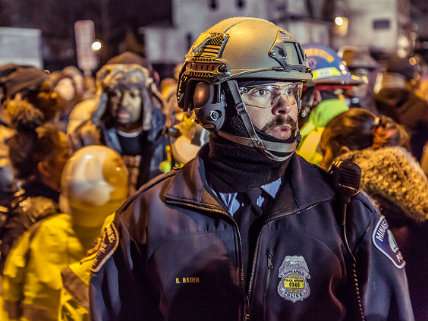Obama May Backtrack on Military Equipment Ban For Police
The president met with police leaders after five officers were killed in Dallas.


President Barack Obama will review a year-old executive order prohibiting the transfer of military-grade weapons to police, according to Reuters.
The president signed Executive Order 13688 in May 2015, banning the transfer of certain military equipment between armed forces and police departments. This included such items as tracked armored vehicles, weaponized vehicles, grenade launchers, and camouflage uniforms. The order came as a result of a 2014 government-wide review of military equipment provided to law enforcement agencies, which was ordered in the wake of the protests in Ferguson, Missouri.
While the order didn't ban all military equipment—certain explosives and armored vehicles were still allowed—it did restrain how these various items could be acquired. And if police departments wanted an item that was prohibited, they would have to purchase it from a private vendor, often at a hefty price.
All of this may soon change: Eight police organization leaders met with Obama and Vice President Joe Biden on July 11—three days after five officers were killed in Dallas—to discuss possible reforms.
Jim Pasco, the executive director of the Fraternal Order of Police, was one of the people in attendance. He told Reuters most police departments cannot afford to pay for this equipment, and that this leaves officers vulnerable to attacks. As an example he pointed to grenade launchers, which he said can also be used to launch tear gas into rowdy crowds. "The White House thought this kind of gear was intimidating to people, but they didn't know the purpose it serves," he said.
Yet Kanya Bennett, legislative counsel for the American Civil Liberties Union (ACLU), says that while police should be able to use this equipment in high-risk situations—such as an active sniper—forces often do not reserve it for such circumstances. "Police departments have been using military equipment to carry out day-to-day operations," she says. "As we saw with the protests in Ferguson and Baton Rouge, a militarized response only escalates tensions and threatens public safety."
When protesters marched in Baton Rouge earlier this month to protest the killing by police of Alton Sterling, more than 100 people were arrested despite the fact that they were demonstrating peacefully. Video footage shows officers, decked out in riot gear and holding rifles, pushing protesters onto private property before handcuffing them.
The ACLU released a report in June 2014 detailing the excessive militarization of police departments. The organization notes that this phenomenon tends to disproportionately affect minority communities and undermines civil liberties.
The White House did not immediately return a request for comment. A White House official told Reuters, however, that the administration frequently reviews the equipment that can be transferred from the military to police departments to ensure that law enforcement agencies have the materials they need to do their jobs.

Show Comments (21)